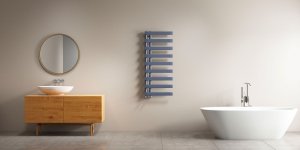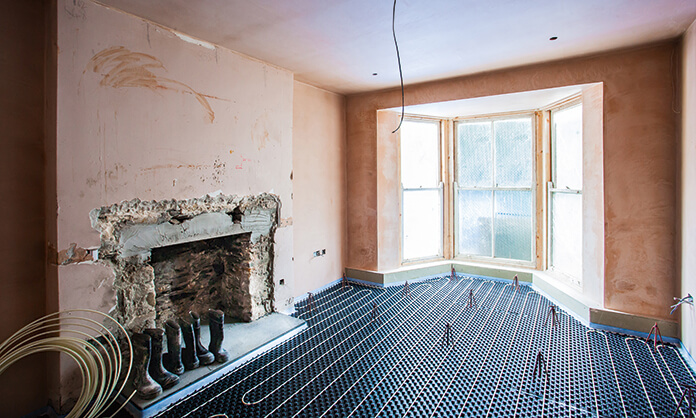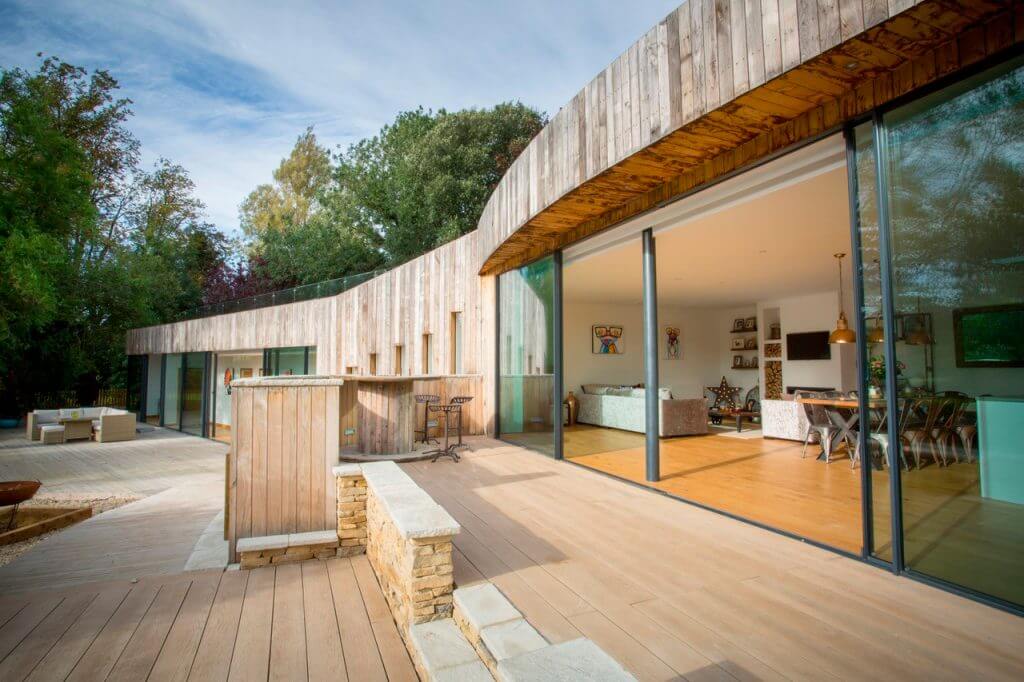Whether you’re self-building, renovating or extending, selecting the right heating system is a major decision.
From design considerations through to energy efficiency, running costs and other practical concerns, there’s a lot to wade through when choosing between underfloor heating (UFH) and radiators. Here’s what you need to know.
Different underfloor heating and radiator designs
Whatever the style of your home, you’ll easily find an underfloor heating system or radiator arrangement to suit your tastes and requirements.
One of the most popular reasons to choose underfloor heating is because, as the name suggests, it is hidden beneath your floor covering. This allows for clean lines and an open flow throughout your home that isn’t interrupted by radiators. It also frees up wall space so will give you the feeling of extra room, too.
There are hundreds of design options when it comes to radiators, so don’t fall into the trap of thinking that you can’t get something to suit your interior scheme.
Vertical radiators are growing in popularity, as their configuration means they don’t have as much of an impact on furniture placement.

The HB Signature Elektra in grey has a simple, fuss-free vibe with chunky, regimented towel rails. Tired of plain old panel radiators? Thankfully there’s a wealth of attractive alternatives out there – and we’ve picked our favourite designer radiators to help you choose something a little more stylish for your living space. Read more: The Best Designer Radiators to Keep Warm During Winter |
In terms of material, aluminum is a strong choice for achieving unusual shapes and finishes, plus it heats up quickly. For period charm, consider column radiators in cast iron. You could even try coating this in a bespoke colour for a modern feel – try Bisque for ideas.
Can I retrofit underfloor heating and radiators?
There are two types of underfloor heating to choose from – wet UFH and dry UFH. The former connects to your central heating system (powered by a boiler or renewable alternative) and warm water streams through piping laid beneath the floor, often set in screed.
Dry UFH runs off of domestic electricity, with electric coils placed under the surface. The advantage of this is that the wiring is quite thin and simple to fit – so there’s relatively little disruption involved during fitting.
Key considerations for heating systems
|
Installing wet UFH can be a more complex process, as it requires more space for pipework. Plumbing connections and tests will need to be carried out and the floor must be properly prepared and insulated in order to ensure the system works efficiently.
There needs to be enough room to accommodate this and the piping, so you might have to elevate the floor level, especially if it’s being retrofitted into an existing space. Because of this, it’s easier to install wet underfloor heating in a new build as these adjustments can be planned from the start.

Nu-Heat’s slimline Lo Pro Max underfloor heating system is designed specifically with retrofit scenarios in mind. It offers a minimal height build-up on top of existing floors, averaging at 22m
However, there are now a lot of low-profile systems available to enable easier installation of wet UFH. Using thin pipework, special screeds or thin overlay boards, these reduce floor height build-up and won’t disturb other fittings as much. Check out Nu-Heat’s LoPro 10 or Polypipe’s Overlay system, which measures just 18mm in depth.
If you’re renovating an old property and updating the radiators, it might be necessary to plan for a new boiler and possibly upgrade the pipework.
You’ll need a qualified heating professional (such as a Gas Safe registered engineer if you are on gas, or OFTEC approved for oil) to do the installation for you. This will involve working with them to choose a suitable boiler, and maybe cold water tank, radiators and suitable controls for the system.
Where do these heat emitters work best?
Underfloor heating is great for use in large rooms – so it’s ideal for open-plan spaces. The gentle warmth of underfloor heating also makes it a good choice for bathroom spaces.
One potential downside is that UFH takes a long time to get up to temperature, so it needs to be on fairly constantly during the heating season (albeit at a low temperature, which leads to good efficiency and cost-savings in use).
When fitting radiators, you ideally need to have one installed every 4m in a room, so they aren’t ideal for large open-plan kitchen extensions, for example. But they work well in bedrooms, which tend to be smaller in size.
What’s more efficient: underfloor heating or radiators?
UFH can be extremely eco-friendly and affordable to run, as long as it’s installed properly and partnered with the correct flooring material so it can conduct heat. Stone, ceramic, engineered timber or vinyl flooring are best, but always check with your supplier before buying.
Wet UFH can be around 25% more efficient than radiators when paired with a modern condensing boiler; and up to 40% more effective when running from a heat pump.
It also tends to work out cheaper to run than electric UFH products, with Nu-Heat suggesting a room size of 10m2 would cost £224 per annum to heat using electric UFH, whereas a wet system would only cost £61 per year.
Closer look: Efficient underfloor heating in a self-build projectJames and Corina Barrett were keen to make their modern self-build in South Oxfordshire as energy efficient and low cost to run as possible. So when considering the best heating setup for their new home, they opted for underfloor heating (UFH) from Nu-Heat with a total of 221.8m2 of high heat-output, pumped liquid screed UFH installed in the house.
Nu-Heat was an easy choice for James. As owner of property development and house building company Ashbrook Homes, he has used the brand in other projects: “I have always found the company to be well-priced, prompt and helpful in the design stage,” he says. “Above all, they offer a great product.” As well as negating the need for radiators, the Nu-Heat UFH system offsets the high heat losses of the mainly glazed new-build, and links up easily with the couple’s home automation system. 
Photos: Ashbrook Homes |
That’s not to say a well-planned radiator setup can’t be efficient, too. However, it’s essential to properly calculate the heat loss of the room (as with UFH) and then find the right sized emitter. The output is measured in BTUs (British Thermal Units) or wattage. There are plenty of online calculators that give a good basic guide to the right output for each room.
Factors such as insulation levels, what type of window glazing you have and how your home’s walls are constructed will all impact on the final score, however, so it’s always best to ask your plumber for advice.
The location of a radiator will affect its performance, too. “Wherever you choose to place your emitter, try not to position it behind large items of furniture as doing so will restrict the flow of hot air around the room,” says Nick Baylis, director of Castrads. “Keep the immediate area surrounding the radiator as open as possible to allow the heat to permeate the space efficiently.”
Can I use underfloor heating and radiators together?
If you’re self-building, UFH is simple to fit as it can be installed as the fabric of the house is being constructed. It’s also likely to be the most efficient choice for your primary heating – although don’t rule out radiators completely. A popular solution is to install UFH on the ground floor and radiators upstairs (in bedrooms, for instance).
UFH tends to be installed fairly early in the build process as part of the first fix work. With radiators, the infrastructure goes in at this stage but the emitters can’t be fitted until the basic decorating has been completed.
The post Radiators or Underfloor Heating? appeared first on Build It.
Article reference Radiators or Underfloor Heating?

No comments:
Post a Comment